instrument panel MITSUBISHI GRANDIS 2008 Owner's Manual (in English)
[x] Cancel search | Manufacturer: MITSUBISHI, Model Year: 2008, Model line: GRANDIS, Model: MITSUBISHI GRANDIS 2008Pages: 458, PDF Size: 18.52 MB
Page 6 of 458
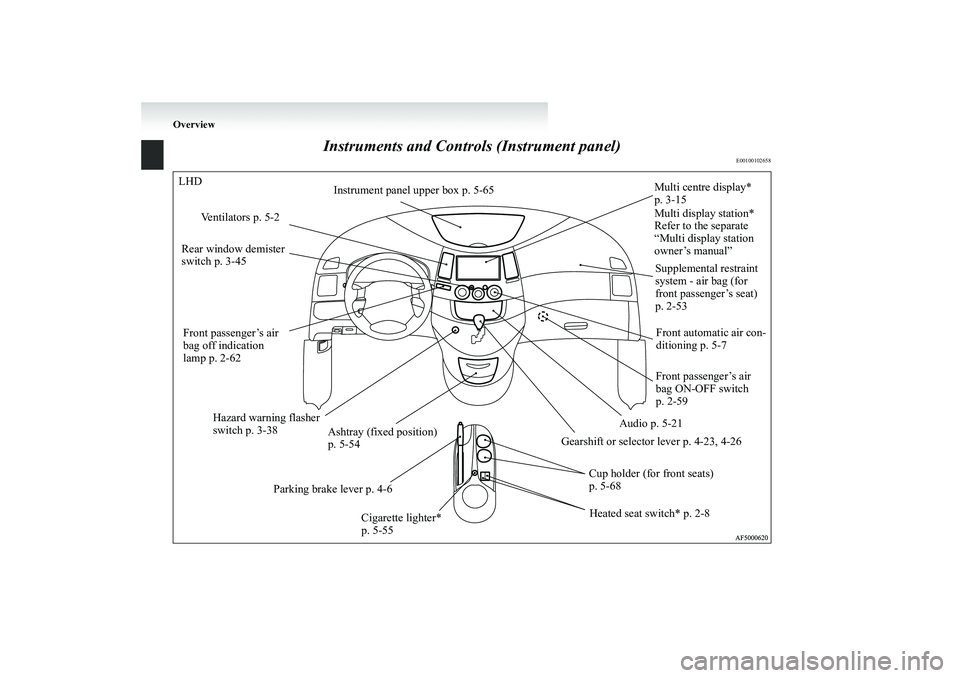
Overview
Instruments and Controls (Instrument panel)
E00100102658
LHD
Multi centre display*
p. 3-15
Ventilators p. 5-2
Rear window demister
switch p. 3-45
Hazard warning flasher
switch p. 3-38
Ashtray (fixed position)
p. 5-54
Cup holder (for front seats)
p. 5-68 Gearshift or selector lever p. 4-23, 4-26
Parking brake lever p. 4-6
Cigarette lighter*
p. 5-55Supplemental restraint
system - air bag (for
front passenger’s seat)
p. 2-53
Front automatic air con-
ditioning p. 5-7
Audio p. 5-21 Instrument panel upper box p. 5-65
Heated seat switch* p. 2-8Front passenger’s air
bag ON-OFF switch
p. 2-59 Front passenger’s air
bag off indication
lamp p. 2-62Multi display station*
Refer to the separate
“Multi display station
owner’s manual”BK-XP08E1ENUK.en-uk.book Page 3 Monday, August 13, 2007 2:20 PM
Page 7 of 458
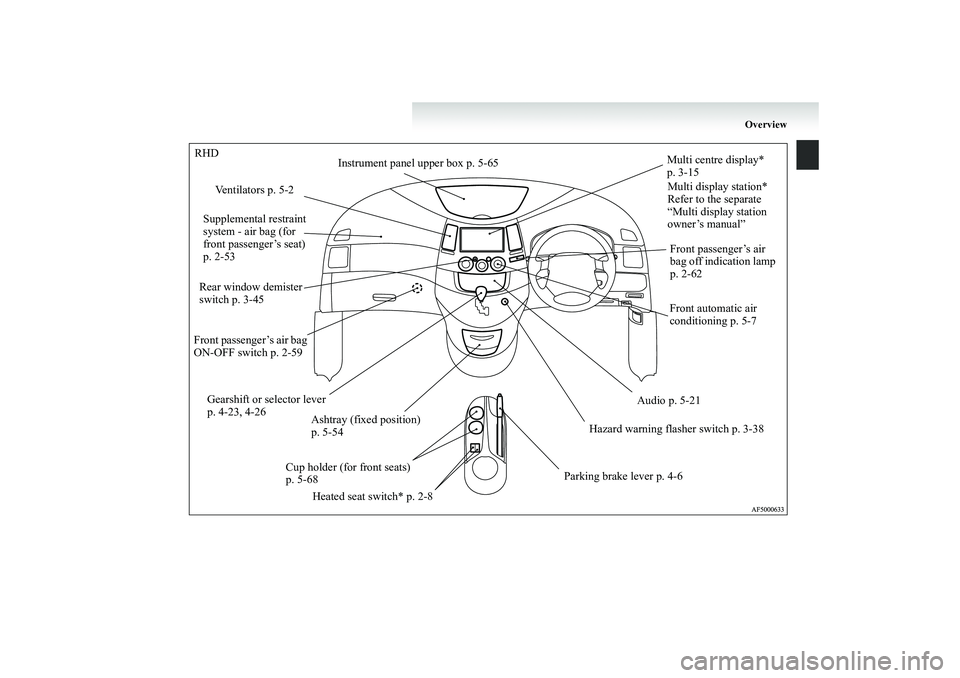
Overview
RHD
Instrument panel upper box p. 5-65
Ventilators p. 5-2
Supplemental restraint
system - air bag (for
front passenger’s seat)
p. 2-53
Rear window demister
switch p. 3-45
Front passenger’s air bag
ON-OFF switch p. 2-59
Gearshift or selector lever
p. 4-23, 4-26
Ashtray (fixed position)
p. 5-54
Cup holder (for front seats)
p. 5-68
Heated seat switch* p. 2-8Hazard warning flasher switch p. 3-38
Parking brake lever p. 4-6Front automatic air
conditioning p. 5-7
Audio p. 5-21Multi centre display*
p. 3-15
Front passenger’s air
bag off indication lamp
p. 2-62 Multi display station*
Refer to the separate
“Multi display station
owner’s manual”
BK-XP08E1ENUK.en-uk.book Page 4 Monday, August 13, 2007 2:20 PM
Page 17 of 458
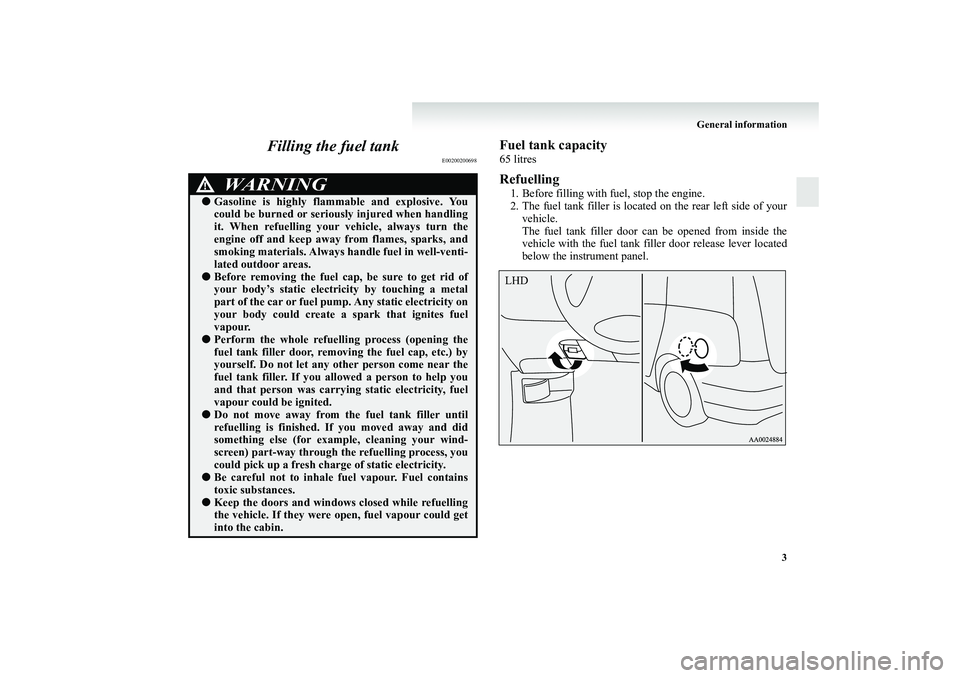
General information
3
Filling the fuel tank
E00200200698
Fuel tank capacity65 litresRefuelling1. Before filling with fuel, stop the engine.
2. The fuel tank filler is located on the rear left side of your
vehicle.
The fuel tank filler door can be opened from inside the
vehicle with the fuel tank filler door release lever located
below the instrument panel.
WARNING
!●Gasoline is highly flammable and explosive. You
could be burned or seriously injured when handling
it. When refuelling your vehicle, always turn the
engine off and keep away from flames, sparks, and
smoking materials. Always handle fuel in well-venti-
lated outdoor areas.●Before removing the fuel cap, be sure to get rid of
your body’s static electricity by touching a metal
part of the car or fuel pump. Any static electricity on
your body could create a spark that ignites fuel
vapour.●Perform the whole refuelling process (opening the
fuel tank filler door, removing the fuel cap, etc.) by
yourself. Do not let any other person come near the
fuel tank filler. If you allowed a person to help you
and that person was carrying static electricity, fuel
vapour could be ignited.●Do not move away from the fuel tank filler until
refuelling is finished. If you moved away and did
something else (for example, cleaning your wind-
screen) part-way through the refuelling process, you
could pick up a fresh charge of static electricity.●Be careful not to inhale fuel vapour. Fuel contains
toxic substances.●Keep the doors and windows closed while refuelling
the vehicle. If they were open, fuel vapour could get
into the cabin.
LHD
BK-XP08E1ENUK.en-uk.book Page 3 Monday, August 13, 2007 2:20 PM
Page 81 of 458
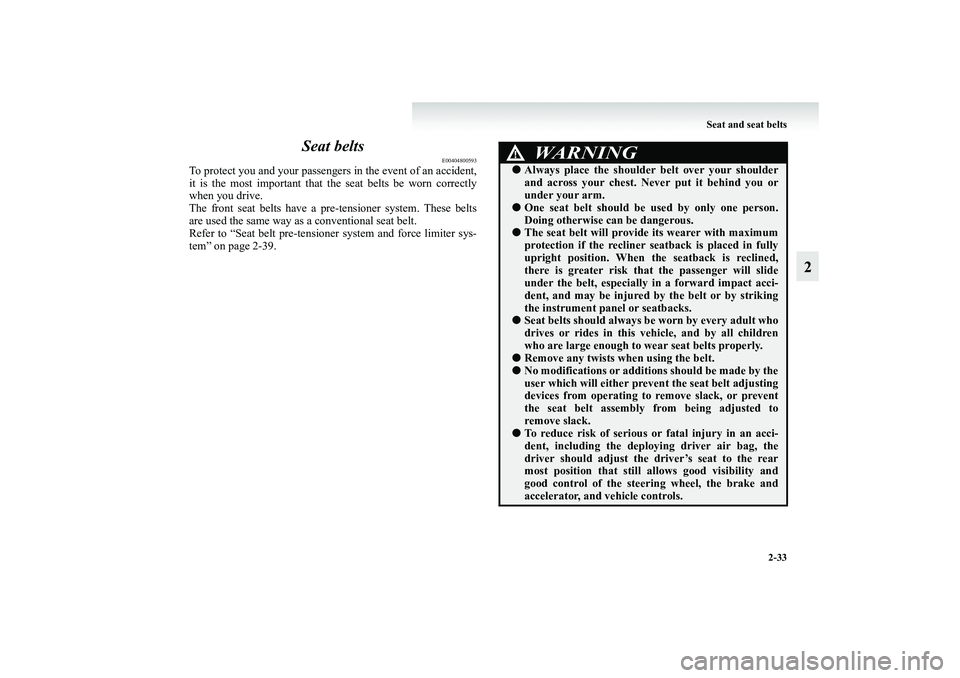
Seat and seat belts
2-33
2 Seat belts
E00404800593
To protect you and your passengers in the event of an accident,
it is the most important that the seat belts be worn correctly
when you drive.
The front seat belts have a pre-tensioner system. These belts
are used the same way as a conventional seat belt.
Refer to “Seat belt pre-tensioner system and force limiter sys-
tem” on page 2-39.
WARNING
!●Always place the shoulder belt over your shoulder
and across your chest. Never put it behind you or
under your arm.●One seat belt should be used by only one person.
Doing otherwise can be dangerous.●The seat belt will provide its wearer with maximum
protection if the recliner seatback is placed in fully
upright position. When the seatback is reclined,
there is greater risk that the passenger will slide
under the belt, especially in a forward impact acci-
dent, and may be injured by the belt or by striking
the instrument panel or seatbacks.●Seat belts should always be worn by every adult who
drives or rides in this vehicle, and by all children
who are large enough to wear seat belts properly.●Remove any twists when using the belt.●No modifications or additions should be made by the
user which will either prevent the seat belt adjusting
devices from operating to remove slack, or prevent
the seat belt assembly from being adjusted to
remove slack.●To reduce risk of serious or fatal injury in an acci-
dent, including the deploying driver air bag, the
driver should adjust the driver’s seat to the rear
most position that still allows good visibility and
good control of the steering wheel, the brake and
accelerator, and vehicle controls.
BK-XP08E1ENUK.en-uk.book Page 33 Monday, August 13, 2007 2:20 PM
Page 102 of 458

2-54 Seat and seat belts
2
WARNING
!●IT IS VERY IMPORTANT TO BE PROPERLY
SEATED.
A driver or front passenger too close to the steering
wheel or instrument panel during air bag deploy-
ment can be killed or seriously injured.
Air bags inflate very fast, and with great force.
If the driver and front passenger are not properly
seated and restrained, the air bags may not protect
you properly, and could cause serious or fatal inju-
ries when it inflates.
• Before driving, adjust the driver’s seat as far back
as possible while still maintaining complete control
of the vehicle.
• Before driving, adjust the front passenger seat as
far back as possible.
• Make sure all vehicle occupants are always prop-
erly restrained using the available seat belts.
• With seat belts properly fastened, the driver and
passenger should sit well back and upright without
leaning against the window or door.
WARNING
!●Do not sit on the edge of the seat, or lean head or
chest close to the steering wheel or instrument panel.
Do not put feet or legs on or against the instrument
panel.●Place all infants and small children in the rear seat
and properly restrained using an appropriate child
restraint system.
The rear seat is the safest for infants and children.
BK-XP08E1ENUK.en-uk.book Page 54 Monday, August 13, 2007 2:20 PM
Page 103 of 458
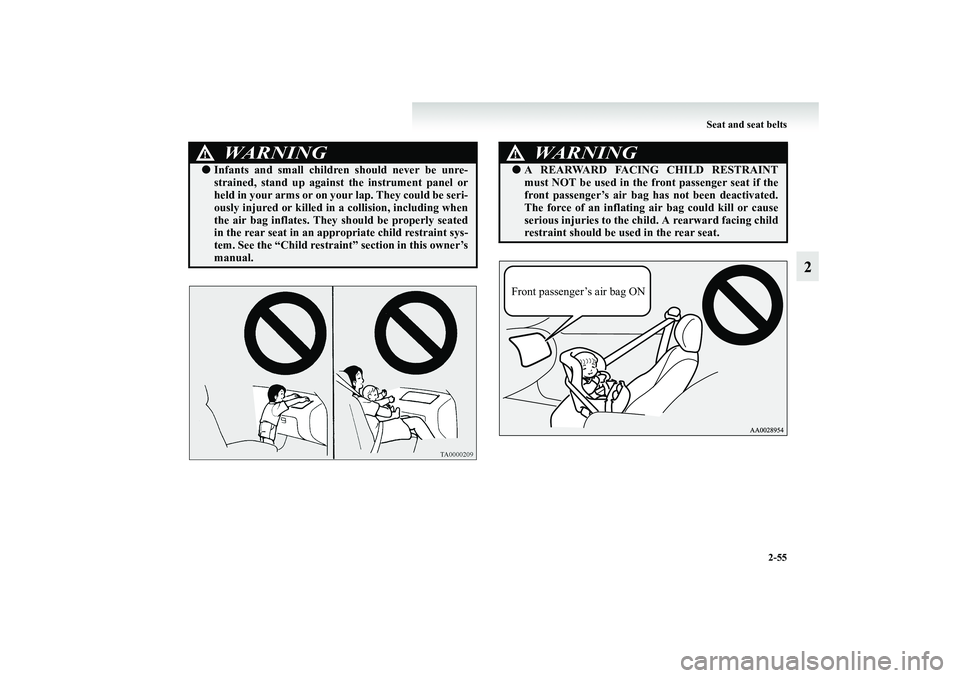
Seat and seat belts
2-55
2
WARNING
!●Infants and small children should never be unre-
strained, stand up against the instrument panel or
held in your arms or on your lap. They could be seri-
ously injured or killed in a collision, including when
the air bag inflates. They should be properly seated
in the rear seat in an appropriate child restraint sys-
tem. See the “Child restraint” section in this owner’s
manual.
WARNING
!●A REARWARD FACING CHILD RESTRAINT
must NOT be used in the front passenger seat if the
front passenger’s air bag has not been deactivated.
The force of an inflating air bag could kill or cause
serious injuries to the child. A rearward facing child
restraint should be used in the rear seat.Front passenger’s air bag ON
BK-XP08E1ENUK.en-uk.book Page 55 Monday, August 13, 2007 2:20 PM
Page 110 of 458
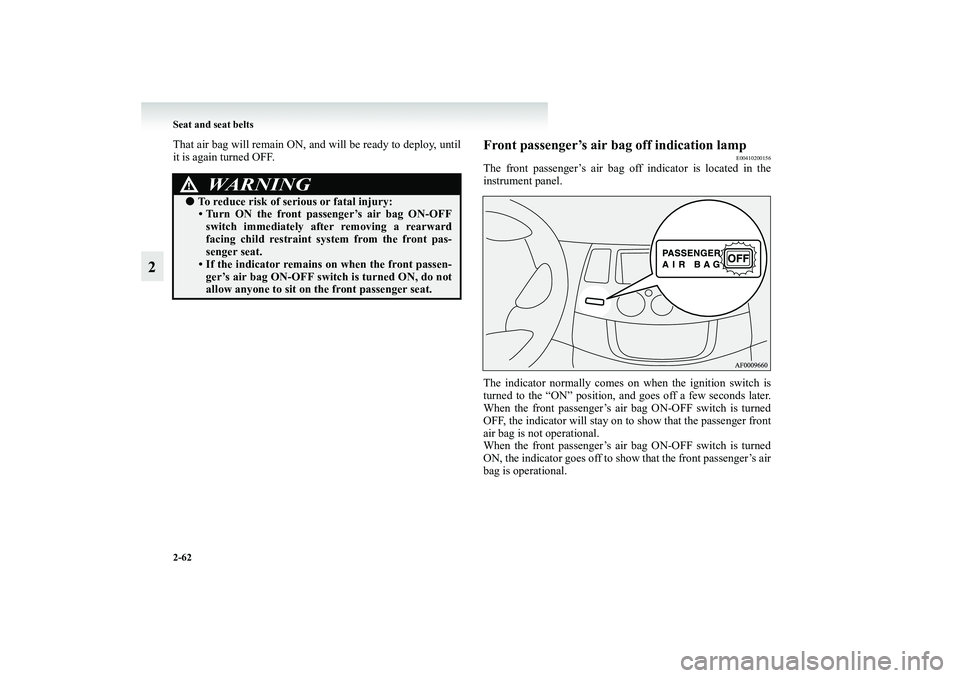
2-62 Seat and seat belts
2
That air bag will remain ON, and will be ready to deploy, until
it is again turned OFF.
Front passenger’s air bag off indication lamp
E00410200156
The front passenger’s air bag off indicator is located in the
instrument panel.
The indicator normally comes on when the ignition switch is
turned to the “ON” position, and goes off a few seconds later.
When the front passenger’s air bag ON-OFF switch is turned
OFF, the indicator will stay on to show that the passenger front
air bag is not operational.
When the front passenger’s air bag ON-OFF switch is turned
ON, the indicator goes off to show that the front passenger’s air
bag is operational.
WARNING
!●To reduce risk of serious or fatal injury:
• Turn ON the front passenger’s air bag ON-OFF
switch immediately after removing a rearward
facing child restraint system from the front pas-
senger seat.
• If the indicator remains on when the front passen-
ger’s air bag ON-OFF switch is turned ON, do not
allow anyone to sit on the front passenger seat.
BK-XP08E1ENUK.en-uk.book Page 62 Monday, August 13, 2007 2:20 PM
Page 111 of 458
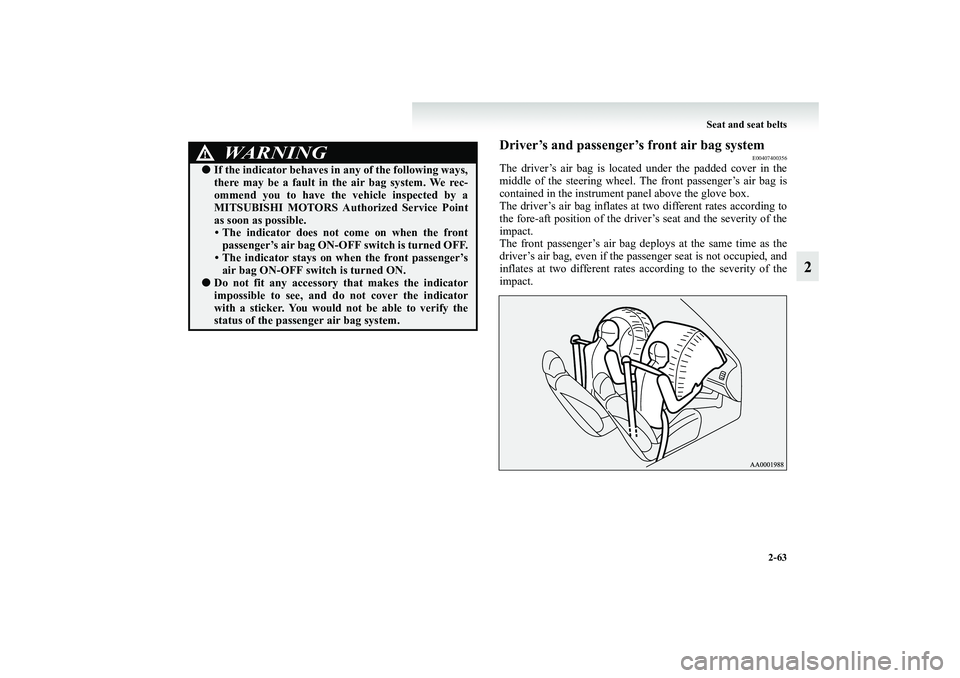
Seat and seat belts
2-63
2
Driver’s and passenger’s front air bag system
E00407400356
The driver’s air bag is located under the padded cover in the
middle of the steering wheel. The front passenger’s air bag is
contained in the instrument panel above the glove box.
The driver’s air bag inflates at two different rates according to
the fore-aft position of the driver’s seat and the severity of the
impact.
The front passenger’s air bag deploys at the same time as the
driver’s air bag, even if the passenger seat is not occupied, and
inflates at two different rates according to the severity of the
impact.
WARNING
!●If the indicator behaves in any of the following ways,
there may be a fault in the air bag system. We rec-
ommend you to have the vehicle inspected by a
MITSUBISHI MOTORS Authorized Service Point
as soon as possible.
• The indicator does not come on when the front
passenger’s air bag ON-OFF switch is turned OFF.
• The indicator stays on when the front passenger’s
air bag ON-OFF switch is turned ON.
●Do not fit any accessory that makes the indicator
impossible to see, and do not cover the indicator
with a sticker. You would not be able to verify the
status of the passenger air bag system.
BK-XP08E1ENUK.en-uk.book Page 63 Monday, August 13, 2007 2:20 PM
Page 112 of 458
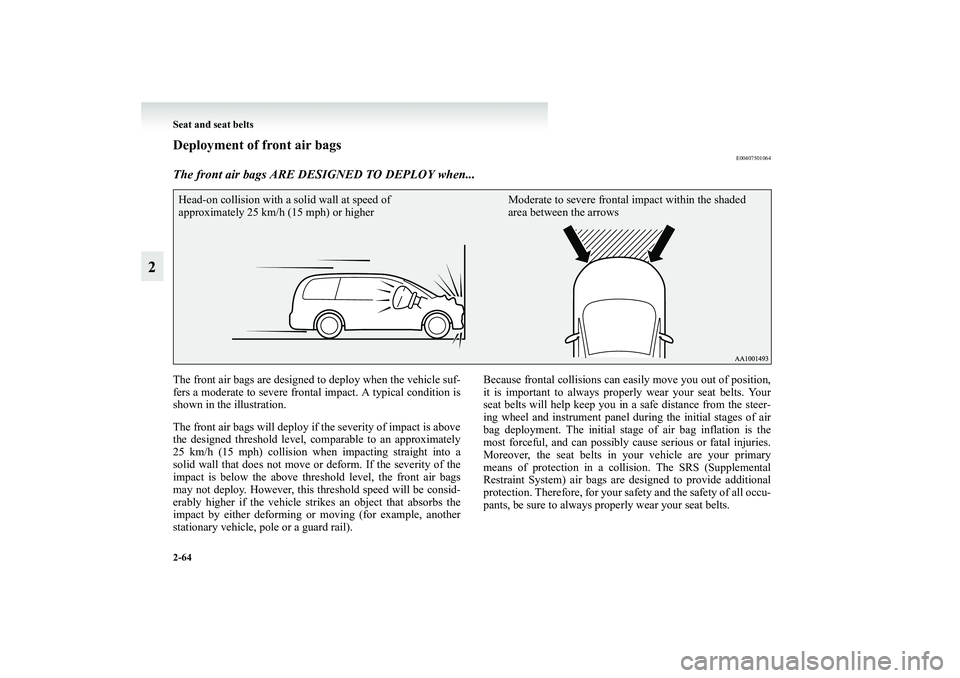
2-64 Seat and seat belts
2
Deployment of front air bags
E00407501064
The front air bags ARE DESIGNED TO DEPLOY when...The front air bags are designed to deploy when the vehicle suf-
fers a moderate to severe frontal impact. A typical condition is
shown in the illustration.
The front air bags will deploy if the severity of impact is above
the designed threshold level, comparable to an approximately
25 km/h (15 mph) collision when impacting straight into a
solid wall that does not move or deform. If the severity of the
impact is below the above threshold level, the front air bags
may not deploy. However, this threshold speed will be consid-
erably higher if the vehicle strikes an object that absorbs the
impact by either deforming or moving (for example, another
stationary vehicle, pole or a guard rail).Because frontal collisions can easily move you out of position,
it is important to always properly wear your seat belts. Your
seat belts will help keep you in a safe distance from the steer-
ing wheel and instrument panel during the initial stages of air
bag deployment. The initial stage of air bag inflation is the
most forceful, and can possibly cause serious or fatal injuries.
Moreover, the seat belts in your vehicle are your primary
means of protection in a collision. The SRS (Supplemental
Restraint System) air bags are designed to provide additional
protection. Therefore, for your safety and the safety of all occu-
pants, be sure to always properly wear your seat belts.Head-on collision with a solid wall at speed of
approximately 25 km/h (15 mph) or higherModerate to severe frontal impact within the shaded
area between the arrowsBK-XP08E1ENUK.en-uk.book Page 64 Monday, August 13, 2007 2:20 PM
Page 115 of 458
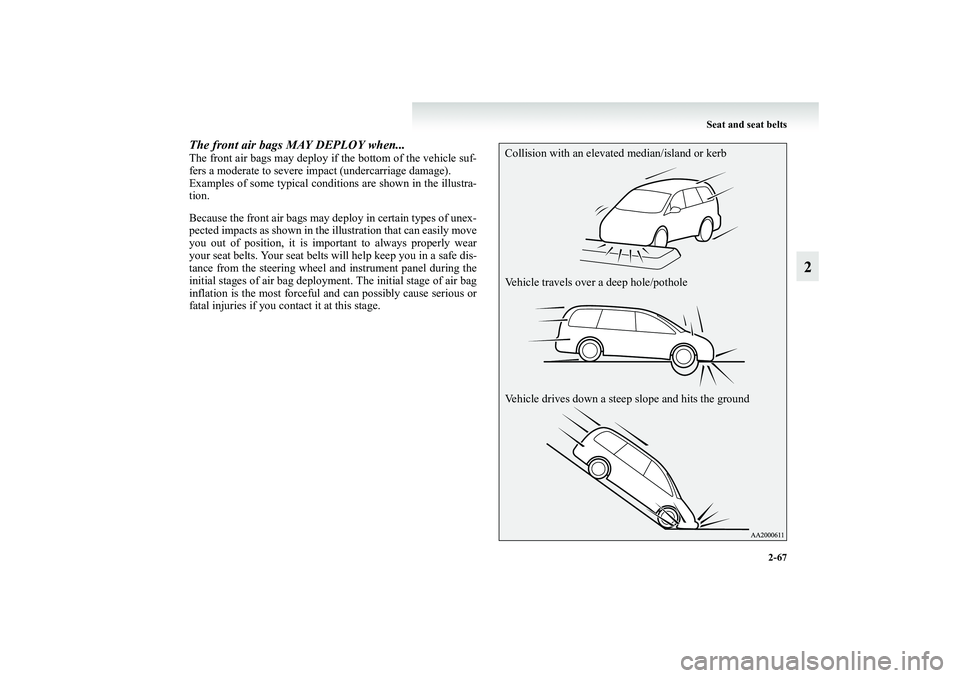
Seat and seat belts
2-67
2
The front air bags MAY DEPLOY when... The front air bags may deploy if the bottom of the vehicle suf-
fers a moderate to severe impact (undercarriage damage).
Examples of some typical conditions are shown in the illustra-
tion.
Because the front air bags may deploy in certain types of unex-
pected impacts as shown in the illustration that can easily move
you out of position, it is important to always properly wear
your seat belts. Your seat belts will help keep you in a safe dis-
tance from the steering wheel and instrument panel during the
initial stages of air bag deployment. The initial stage of air bag
inflation is the most forceful and can possibly cause serious or
fatal injuries if you contact it at this stage.
Collision with an elevated median/island or kerb
Vehicle travels over a deep hole/pothole
Vehicle drives down a steep slope and hits the ground
BK-XP08E1ENUK.en-uk.book Page 67 Monday, August 13, 2007 2:20 PM